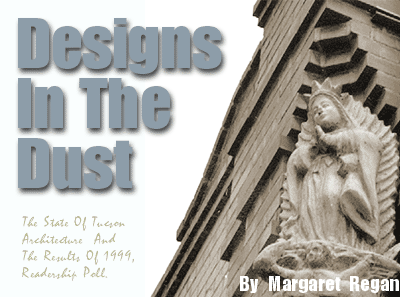
IN 40 YEARS of designing buildings in Tucson, Bob Swaim
has housed giraffes and polar bears, made classrooms for litt
place to get their aches and pains checked out. He's an affable
man with an easy grin, and in his semi-retirement he dresses Tucson
casual in plaid shirts and jeans. As an architect, though, he
tends toward the formal.
He loves soaring glass and sleek steel, the techie architectural
elements charged with carrying out the famous dictum of modernism:
form follows function. When Swaim trained at the University of
Nebraska back in the '50s, the architecture professors there,
and nearly everywhere else, were fired up with the new vision
of the international style, whose simplicity would sweep away
the fussy Beaux Arts classicism of the past.
"They were teaching Le Corbusier, Mies van der Rohe, the
Bauhaus, with its emphasis on glass and steel," Swaim remembers.
"It's what I love."
 The headquarters for Swaim Associates, now run by his son, show
Swaim practices what he preaches. It's a glass-and-steel affair
atop big concrete stilts, its north facade ornamented by a shiny
steel piping twisted into angles that mimic the jagged Catalinas
a short distance away. Floor-to-ceiling windows not only flood
the place with light, they frame a view of kids running in the
Davidson Elementary schoolyard across the street, and the mountains
towering above.
The headquarters for Swaim Associates, now run by his son, show
Swaim practices what he preaches. It's a glass-and-steel affair
atop big concrete stilts, its north facade ornamented by a shiny
steel piping twisted into angles that mimic the jagged Catalinas
a short distance away. Floor-to-ceiling windows not only flood
the place with light, they frame a view of kids running in the
Davidson Elementary schoolyard across the street, and the mountains
towering above.
Swaim housed his own family in a modernist piece of geometry
at desert's edge, a domicile that has several times been pictured
in national magazines. At the Reid Park Zoo, the giraffes have
enjoyed such an excellent rate of reproduction in a Swaim enclosure
that he has a standing joke about his animal clients: "We
like to say the giraffes are obviously satisfied."
His firm recently designed the playful Robins Elementary, whose
pyramid roofs and bright purples play off the forms and colors
of the nearby Tucson Mountains. More controversial in the pyramid
department is Swaim's upside-down one at Wilmot and Speedway,
a Western Savings Bank building whose owner was determined to
create a memorable landmark.
"Our most infamous project," Swaim calls it, and indeed
the shimmering bank has made it onto lists of both best and worst
architecture of Tucson.
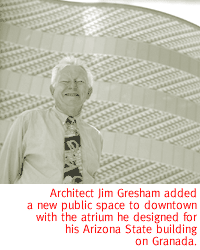 So Swaim was somewhat taken aback when his modest Orchard River
Townhomes were nominated by a panel of local pros as a Tucson
Architectural Landmark.
So Swaim was somewhat taken aback when his modest Orchard River
Townhomes were nominated by a panel of local pros as a Tucson
Architectural Landmark.
"I was surprised it was nominated," he says. "But
Judith Chafee (the respected late UA prof and architect) lived
there. In fact, lots of architects have lived there. Architects
like it."
Architects are not the only ones. Voters named it the top contemporary
building in the Tucson Architectural Landmarks Contest co-sponsored
by the Tucson Weekly and the UA College of Architecture.
Along with Broadway Village, the early shopping center that won
in the historic category, Orchard River now takes a permanent
place on the list as a landmark.
Contest voters had to choose from five contemporary and five
historic buildings. Some of the most popular Tucson buildings--from
Mission San Xavier to the UA's Old Main--were not eligible this
election, having already achieved hall of fame status. Readers
gave Orchard River first place; in a separate poll local architects
gave it second, but the combined votes pushed it up into first
place overall. The professionals preferred the First National
Bank of Arizona, a crisp brick-clad steel building at Stone and
Alameda downtown. Designed in 1968 by William Engelhardt, the
building's modern lines are softened by shade arches on the south
and west.
Readers were lavish in their praise of Orchard River.
"If subsequent architecture had followed in Bob Swaim's
humane footsteps, what a wonderfully different city Tucson might
have become," wrote Bruce Parsil on his ballot.
"I always knew I had good taste and bought a winner,"
declared Jennifer W. Shaw. "I've been here since 11/80."
"Obviously, I like Orchard River--I have lived here since
April 1974!" wrote voter Virginia Moyer.
Nowadays, when developers routinely blade and grade mass housing
sites, leaving them desiccated dust bowls devoid of plants and
wildlife, Swaim's preservation of the trees at Orchard River verges
on the saintly. The complex was to be built on the site of a pecan
orchard east of Fort Lowell Park and just south of the Rillito.
Swaim explains that it was a relatively simple matter to gerrymander
the design so the trees could be spared.
"We could have saved a lot of money by tearing out all the
trees, but we thought there ought to be a lot we could save,"
he remembers. "The trees were planted in a grid, and the
townhouses were a little like modules. We sited the thing to save
the trees in the common space."
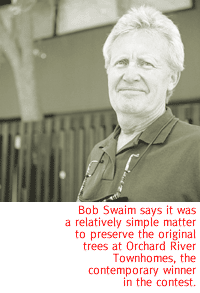 That long-ago sacrifice of greater profit for better design still
bears fruit today. The chirping of birds is the loudest noise
at the complex; they nest in the pecan trees that form a shady
bower along the pedestrian pathways. Residents walk through the
public spaces under the trees to get to their front doors, Swaim
having exiled cars to covered parking lots. Out back, the attached
houses have private walled backyards. Swaim oriented the houses
north and south, to avoid the long heat of the summer mornings
and afternoons.
That long-ago sacrifice of greater profit for better design still
bears fruit today. The chirping of birds is the loudest noise
at the complex; they nest in the pecan trees that form a shady
bower along the pedestrian pathways. Residents walk through the
public spaces under the trees to get to their front doors, Swaim
having exiled cars to covered parking lots. Out back, the attached
houses have private walled backyards. Swaim oriented the houses
north and south, to avoid the long heat of the summer mornings
and afternoons.
The place's connection with nature didn't preclude a modernist
aesthetic, though. The materials don't pretend to be what they're
not. The block walls offer a backdrop for the houses' geometric
grid of windows and doors. Polished concrete floors indoors are
flooded with light from clerestory windows.
Architects, visual creatures that they are, were silent about
their votes, but Swaim has his own theories about why they like
the place.
"It has a simplicity. It doesn't have a tile roof and arches.
People who live there can do what they want with it."
TILE ROOFS AND arches, however, won out in the contest's
historic category. Broadway Village, built back in 1939 at the
corner of Broadway and Country Club as Tucson's first-ever official
shopping center, beguiled the architects with its traditional
allusions and graceful procession of spaces. Gathered around a
series of courtyards, Josias Joesler's clustered stores celebrate
the pedestrian experience.
Broadway Village may have won the architects' hearts, but in
the readers' poll it tied for third place. The total votes in
the two polls pushed the center to the top overall. The highest
reader vote-getter was Safford School, a more extravagant example
of the Spanish Colonial Revival, complete with tile roofs and
an elaborately carved portico reminiscent of San Xavier. The 1918
school has the distinction of being designed by a woman, A.G.
(Annie) Rockfellow, a prolific architect whose 20 years in Tucson
yielded a number of memorable public buildings, including the
late, lamented El Conquistador Hotel.
Broadway Village's Joesler was a Swiss architect who traveled
widely, soaking up architecture in the hot regions of Europe,
Northern Africa, Cuba, Mexico and Southern California before coming
to Tucson in 1928. He was recruited by developers John and Helen
Murphey, the couple who made a fortune developing the Catalina
Foothills. Before his death in 1956, the prolific Joesler designed
more than 400 buildings in town, including many of the early Foothills
houses now prized by owners and real-estate agents alike. His
public works include St. Philip's in the Hills (1936) and St.
Michael's and All Angels (1953), both Episcopal churches.
Much of the thriving commercial district of Fourth Avenue is
Joesler too, according to fan Bob Vint, an architect whose firm,
Bob Vint Associates, is housed in a Joesler storefront nearby
on Sixth Avenue. People like Joesler's work for its courtyards,
ceramic tiles, ornamental ironwork and carved doors, but Vint
believes it's a mistake to consider a Joesler as just a collection
of pretty details.
"Joesler has a sense of scale and proportion that modern
architects don't seem to have," says Vint. "Broadway
Village is interesting not for its building forms, which are quaint
and revivalistic, but for the way you move through space...It's
too bad people didn't follow his lead."
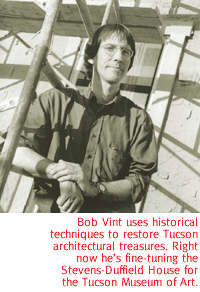 To create the feeling of a Mexican plaza, Joesler fashioned arcades
and courtyards, using distressed bricks and tilework, the kind
of visual detailing that pedestrians--but not motorists--can appreciate.
And, he sequestered automobiles in a shaded lot out back.
To create the feeling of a Mexican plaza, Joesler fashioned arcades
and courtyards, using distressed bricks and tilework, the kind
of visual detailing that pedestrians--but not motorists--can appreciate.
And, he sequestered automobiles in a shaded lot out back.
THE HIDDEN PARKING lot was an innovation, like Swaim's
preservation of the pecans, that for better or worse didn't take
root in Tucson. A few other upscale shopping plazas learned the
Joesler lesson, St. Philip's Plaza and Palomino Plaza among them,
but commercial developers intent on accommodating the burgeoning
car culture ignored it. Storefronts eventually became three-dimensional
billboards, big boxes easily visible to cars speeding by. Parking
lots were jammed in front of strip shopping centers. With the
birth of the mall, stores turned into islands of utilitarian architecture
afloat in vast seas of parking blacktop.
New houses in Tucson have followed a startlingly similar path.
With a few exceptions, including Landmark nominee Manlove Studios,
an infill townhouse project by Rick Hoffman and Arthur Perkins,
subdivisions have been spawned by the freeway. Their houses' main
design feature is the double-wide garage door, a physical manifestation
of car love. The tile roofs mimic historic styles in the most
superficial way possible. Often they're sited by an out-of-town
architect, who doesn't bother to place them in any coherent relationship
to their physical surroundings. And unlike Swaim, their builders
don't bother to save the trees.
If the contest winners point up Tucson's road not taken, their
distinct styles highlight a philosophical divide among contemporary
architects. Some remain passionately committed to the ideals of
modernism modestly embodied by Orchard River, while others believe
that we can happily make use of architectural ideas developed
in the past.
JIM GRESHAM IS a cheerful man with a full head of white hair sprouting
above a round face. He presides over the city on the seventh floor
of a downtown skyscraper with views clear across the valley as
far as the Tortolitas. Gresham is proud of his 1988 Canyon View
Elementary School, a contest nominee. "The best school in
town," he declares, "one of my favorites of all our
jobs." Like Swaim, Gresham strove to preserve the rich desert
fauna on the site, dividing the school into a series of classroom
buildings connected by a covered walkway and even a bridge over
an arroyo.
Gresham's works include the Armory Park Senior Center and downtown's
Arizona State building on Granada. Right now his firm, Gresham
& Beach, is at work on one of the most unusual projects in
Tucson: the UA's "integrated learning center," which
will be hidden underground below the grassy mall. Though Gresham
prides himself on his modernist bent, his tastes run to the historic
and the modern alike, and he cites the UA's Old Main and the ornate
Benedictine Convent on Country Club as among Tucson's finest buildings.
A former UA architecture prof, he's thought a lot about public
space and he peppers his conversation with erudite references
to Italian piazzas and palazzos. He hates the thoroughfares Tucson
has created for cars, singling out the slapdash fast-food joints
and car washes of East Speedway for special scorn.
"We haven't caught up with the automobile," he says.
"We don't know how to plan for it."
Yet he's not convinced that Joesler's Broadway Village's parking
solution could have served as a model for large-scale future commercial
development.
"I'm not so sure you could make it a successful pattern,"
he says. "It's kind of small. Magnified, I'm not so sure
the same dynamic would pertain."
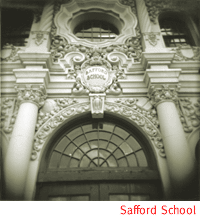 Contemporary Tucson architect Les Wallach, a fervent modernist
whose many commissions include the new restaurant gallery complex
at the Arizona Sonora Desert Museum, goes Gresham one further.
He sees Joesler as a hopeless romantic, the forebear of the taco
deco style that infests Tucson's commercial strips today--every
burrito joint a tiny arcaded mission--and the faux hacienda subdivision
houses, every roof tiled in red.
Contemporary Tucson architect Les Wallach, a fervent modernist
whose many commissions include the new restaurant gallery complex
at the Arizona Sonora Desert Museum, goes Gresham one further.
He sees Joesler as a hopeless romantic, the forebear of the taco
deco style that infests Tucson's commercial strips today--every
burrito joint a tiny arcaded mission--and the faux hacienda subdivision
houses, every roof tiled in red.
"People love Joesler and they don't know why," declares
Wallach. He's a die-hard modernist who nevertheless houses his
firm, Line and Space, in a renovated West University bungalow.
"In effect, Joesler in the '30s was doing a kind of Disneyland
architecture. He imported fantasy styles that had nothing to do
with the climate. It was a fantasy image of old Mexico."
Almost worse, he says, is that Joesler didn't have a clue how
to build in the steaming Sonoran.
"The myth is perpetuated that Joesler houses fit the desert,"
but the more authentic Tucson style, he says, is embodied in the
adobe houses of the barrio now more than 100 years old. "They
had thick walls and narrow window openings: they responded to
the (desert) environment."
Wallach's own work, which includes private houses, the Boyce
Thompson Arboretum visitor's center, and the memorable toilets
along the Santa Cruz River Walk, has won international attention.
Just last week, an Italian photographer was skulking around town
shooting his buildings. Like Gresham, Wallach prefers to use local
materials. For his own Foothills house, he used rock quarried
from the Catalinas. He favors roof overhangs to ward off the sun
and bursts of bright color that mimic the bright-blue skies of
Arizona and its vivid purple flowers. These features, he says,
all hearken back to Mexican architectural solutions for the desert.
And yet they're contemporary.
"It's influenced by Mexican design in a more abstract way,"
he says. "Rather than copying it--you move it forward."
Joesler-advocate Vint has made a name for himself too, with his
inventive investigations of the techniques people used in the
past to cope with the fierce local climate. He was featured on
the PBS program This Old House in connection with his restoration
work on San Xavier, part of which entailed fashioning a building
skin out of an old-fashioned recipe of lime and cactus juice.
He's younger than Wallach, Gresham and Swaim--a generation further
removed from the modernist revolution. Vint hates faux historicism
as much as the next architect--the new Spanish-y Barnes and Noble
on the eastside is an outrage, he says--but he disagrees vehemently
that Joesler's works are corny fakes.
"Broadway Village is good architecture because it's manipulation
of space," he says excitedly. "But Joesler enriched
the space with tiles and things that delight the eye. If we reject
that, we lose something...Les is completely wrong. Joesler was
a good architect. His buildings used real materials, adobe and
tile...If you do it (Spanish Colonial Revival) convincingly, with
the right material, it's good for the climate.
"Les would say my attitude is nostalgia, but the qualities
of scale and proportion are more humane."
Vint himself freely employs historical elements in his own buildings.
He put verandas and sleeping porches in a privately commissioned
house, and for a brand-new adobe in the barrio, he outfitted a
traditional courtyard L-shape with modern technology. He made
an Elders' Center for the Tohono O'odham that used wood beams
and black stone from the nation's sacred mountain. Together with
Jody Gibbs, he designed the Southside Presbyterian Church. The
central sanctuary in the round recalls a Hopi kiva, yet its simplicity
and honest materials obey all the mantras of modernism.
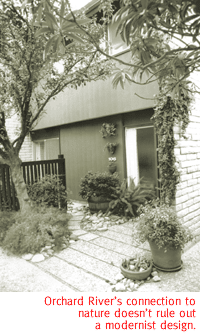 "There's a thing called culture," Vint says. "You
can extend the use of architectural forms from the past.
Throwing out the baby with the bath water is what modern architecture
did. It's shortsighted."
"There's a thing called culture," Vint says. "You
can extend the use of architectural forms from the past.
Throwing out the baby with the bath water is what modern architecture
did. It's shortsighted."
MORE OFTEN THAN not, the general public tends to agree.
Reader Gayle G. Hartmann took contest organizers to task for steering
the public away from the historic past by forcing a vote on a
contemporary building.
"I happen to like the buildings that reflect the past for
the simple reason that such buildings (even newer ones such as
Broadway Village) seem to fit better into our surroundings. So,
maybe instead of trying to force us to like Tucson General Hospital,
etc., we should be looking at new buildings that either (1) remind
us of our past (for example, St. Michael's School), or (2) are
truly environmentally sound (Dave Taffett's houses on Fourth and
Tucson)."
Kirby Lockard, a retired UA architecture professor and something
of an elder statesman of architects in town, readily agrees that
modernism spawned many bad buildings.
"Modernism kind of became an excuse," he says. "We
stripped buildings and we began to sell cheap buildings...Modern
architecture became the excuse for people without much ability:
they made the box with the plain punched windows. They convoluted
the modernist philosophy."
Public antipathy to modernism erupted in the controversy over
the Blackwell House, a Judith Chafee design whose site had become
public, a part of Tucson Mountain Park. Local architects prized
the poured concrete building for its intelligent relationship
to the site and its minimalist outlines, but a vocal populace
called it a bunker. Architecture students organized a campaign
to save the place a few years back, but the unoccupied building
continued to deteriorate at the hands of vandals. Fed up, the
county supervisors eventually bulldozed it.
"Judith was a very good architect," Lockard says. "I
think more than the design of the house; it was the location (that
upset people)."
Still, it's a puzzle that the public becomes outraged by low-key
modernism like the Blackwell House and yet remains curiously silent
over buildings like Target and Walmart. For if Spanish Colonial
Revival is to blame for every hokey pink neo-hacienda, the big
box store is modernism's bastard child.
"Target is a hellish space," says Vint, "it has
an enormous blank anonymous facade."
Architects blame poor city and county planning for the mess of
Tucson's commercial thoroughfares. Zoning requires stores to stand
far back from the road, preventing any kind of harmonious streetscape
and making life downright precarious for the pedestrian. And out-of-town
chains like Target will only do what's required, its big installation
at Roger and Oracle being a case in point. It's an overbearing
building, facing west over a sizzling parking lot unshaded by
a single tree.
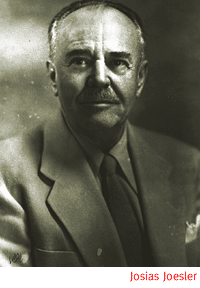 As Lockard says, "The ugliest part of Tucson is the distance
between the curb and the building...We are so eager to promote
development we give away the store."
As Lockard says, "The ugliest part of Tucson is the distance
between the curb and the building...We are so eager to promote
development we give away the store."
The ubiquitous subdivisions suffer from the same lack of serious
architectural input. Typically, a developer uses an out-of-town
architect to rubber-stamp a design that might get built in California
or Tucson or Cleveland, with only slight regional variation. Gresham
found his prized Canyon View School, with its careful preservation
of the flora, surrounded by the worst kind of scorched-earth development,
right across from Sabino Canyon. Years ago when Swaim was head
of the local American Institute of Architects, he says he got
thrown out of a sales office when he marched in to protest a developer's
slicing off a beautiful Foothills hilltop. The developers cry
affordable housing to justify their junk buildings and their large-scale
blading and grading.
Lockard once again apologizes for architects' sins of omission.
"A lot of it's our fault. Our profession after World War
II got out of housing design, except for stock plans. Generally
the profession gave up housing."
Most architect-designed houses are upscale, expensive and one-of-a-kind.
Lockard says when he retired, he and his wife wanted to move to
a smaller house, but he found to his chagrin that he couldn't
afford to build a house of his own design. So the couple bought
a place at an infill project at River and Mountain. At least it
was architect-designed, by Robinette Architects. It makes use
of Texas vernacular elements: pitched tin roofs, wide porches
and pungent color.
Rick Hoffman and Arthur Perkins, architects for the 1988 Manlove
Studios, say they were committed to building low-cost housing
in Barrio San Antonio, an old neighborhood east of downtown where
no new houses had been built in 50 years. They kept costs down
in the live/work studios by using inexpensive materials like block,
but insisted on plenty of natural light and a central landscaped
patio.
The architects were willing, Hoffman says, to wait a while for
their investment to come back in, knowing that "the way to
assure long-term appreciation was by stimulating the neighborhood
to improve. We attempted to be good neighbors, prudent but not
selfish."
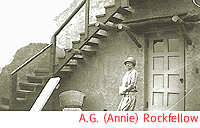 Wallach suggests, only partly tongue in cheek, his Santa Cruz
bathrooms as a model for architecture-designed affordable housing.
People wondered why he was bothering to design a bathroom, he
says, but the single design was duplicated all up and down the
river. A well-designed, modest residential housing development
could be economical in the same way.
Wallach suggests, only partly tongue in cheek, his Santa Cruz
bathrooms as a model for architecture-designed affordable housing.
People wondered why he was bothering to design a bathroom, he
says, but the single design was duplicated all up and down the
river. A well-designed, modest residential housing development
could be economical in the same way.
Vint made affordable housing for a farmworkers' co-op in rural
Arizona, along with Gibbs. They used the old-time model of the
Sonoran rowhouse, grouping the L-shaped houses around private
courtyards. But when Vint tried to sell a similar idea to a commercial
developer in Tubac, the collaboration self-destructed.
The developer loved the high density. (More houses to sell!)
But he hated the purity of the barrio design, which, as Wallach
and Vint both have found, has a resonance with the simplicity
of modernism. The money man found another architect, who subjected
Vint's design to the exact kind of glitzy re-do that so enrages
both Wallach and Vint. The honest rowhouses were bastardized by
fake tile roofs and curving ornaments, a cutesy Mexicanization
that would fit right in at the local fast food parlor.
"They did this revivalist crap," says Vint in disgust.
"They tarted it up."
And the Winners Are:
Here are the official results of the Tucson Architectural Landmarks
Contest
Overall Winners
Historic: Broadway Village Shopping Center
Contemporary: Orchard River Townhomes
Lay People's Winners
Historic: Safford School
Contemporary: Orchard River Townhomes
Architects' Winners
Historic: Broadway Village
Contemporary: First National Bank of Arizona
Architecture Week Activities
Exhibits:
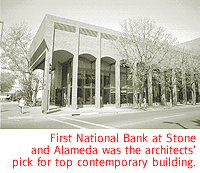 Tucson Design of Its Time and Place, organized by Civitas
Sonoran: the Environmental Design Council, and exhibited in the
main lobby of the Tucson Museum of Art, 140 N. Main Ave., through
Friday, April 30. The exhibition showcases the work of local architects.
Hours are 10 a.m. to 4 p.m. Monday through Saturday, noon to 4
p.m. Sunday. Museum admission is $2, free on Tuesdays. For information
call 624-2333.
Tucson Design of Its Time and Place, organized by Civitas
Sonoran: the Environmental Design Council, and exhibited in the
main lobby of the Tucson Museum of Art, 140 N. Main Ave., through
Friday, April 30. The exhibition showcases the work of local architects.
Hours are 10 a.m. to 4 p.m. Monday through Saturday, noon to 4
p.m. Sunday. Museum admission is $2, free on Tuesdays. For information
call 624-2333.
Tucson Architectural Landmarks, a hall of fame show of
some of Tucson's best buildings, will be on view through Sunday,
April 25, in the center court of the Tucson Mall, 4500 N. Oracle
Road, near the merry-go-round. Free.
The work of Tucson industrial designer Kevin Mills will
be exhibited in the T.M. Sundt Design Gallery, in the UA College
of Architecture, through April 30. The gallery is open Monday
through Friday from 8 a.m. to 5 p.m.
Lecture:
Kevin Mills will give a free talk about his industrial
design projects at 4 p.m. Friday, April 23, in the UA College
of Architecture auditorium. The lecture is part of a continuing
architecture series called Light And Matter.
Home and Building Tour:
Six houses, three new public buildings and a church in the round
will be open to the public from 11 a.m. to 5 p.m. Sunday, April
25. The tour is organized around the theme Regional Design
and Responses of the Built Environment. Tickets are $15 general,
$10 for students. Call 622-6248 for tickets and a tour
map.

|





